2023 Update: Periodic inspection and the occasional cleaning of your HVAC Evaporator Coil are critical home maintenance tasks to ensure optimal indoor air quality.
No matter when you use your central A/C and heating system (for summer cooling and also winter heating), the air pushed through all the rooms of your house will flow through and over your Evaporator Coil. So, keeping this vital part of your HVAC system as clean as possible will help to minimize the dirt and allergens in the air of your home. “But what about all those AC Furnace Air Filters I buy and replace every 3 months – don’t they handle this?” They’re the first line of defense, yes. They’re imperative!
But where does the dirt go if it gets past the air filters or if, perhaps, you missed a few months??
In the summary below, I’ll share photos of my personal experiences so you can see what this entails, and why I personally choose to always hire a local HVAC Professional to handle this, even though I’m a life-long DIY guy. First, though, have a look at the Amazon link in the first line above… not because I want you to buy an Evaporator Coil, but because I want you to see how expensive they can be. The price you see there, for a 4-5 Ton replacement coil, does NOT include installation.
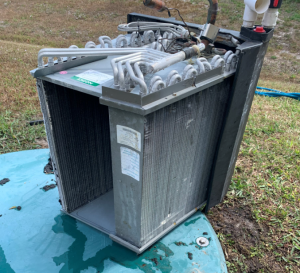
Proper maintenance of your Evaporator Coil (and your HVAC system in total) will help to ensure the highest possible quality air within your home – and also help to extend the life of your expensive home air conditioning and heating system.
But let now me show you, more specifically, what I mean…
Home HVAC System Anatomy
I won’t go into much detail here – but the basic pieces are important to understand.
Just below is a “closed and open” shot of my basement Air Handler, which contains my Evaporator Coil. I’ve annotated it a bit for extra clarity. The Air Handler is the ‘inside the house’ portion of your HVAC system. Not only does it contain the Evaporator Coil, but also the blower motor (for circulating air) and your gas furnace as well. Or alternatively, an electric heat strip.
This is all separate from the ‘outside the house’ portion of your HVAC system, the unit we all need to avoid hitting with our lawn mowers. This is the Condenser unit (picture at the link) – which also contains a compressor within. This portion of the HVAC system facilitates the A/C ‘cooling’ exchange. It compresses the coolant and routes it back into your house.
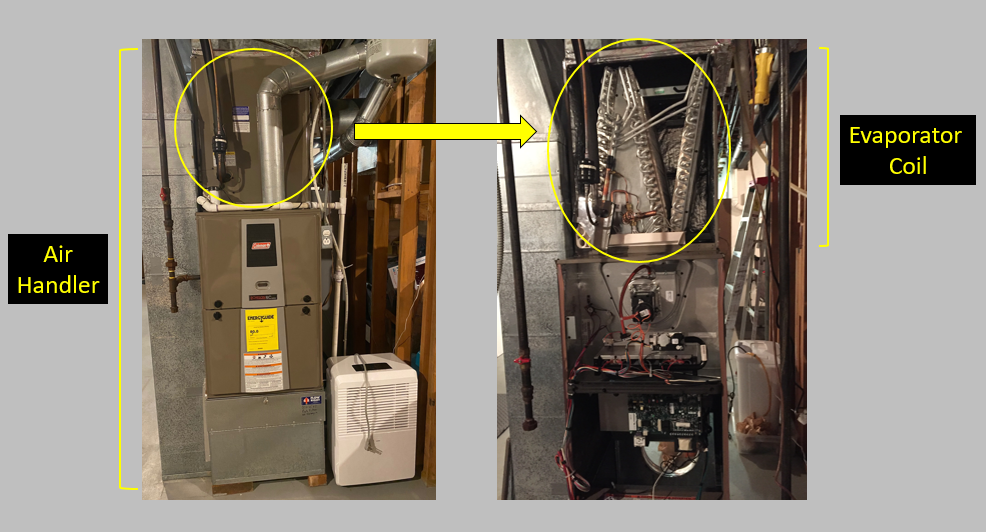
When that [now expanding] coolant hits the Evaporator Coil in your Air Handler, the warm humid air from your house is blown over it – reducing the air’s temperature. Cooling it. This cool air then heads to your home office and kitchen! When this air cooling occurs inside the Air Handler, though, any humidity within that air condenses to water. Hence, the Evaporator Coil gets very ‘wet’ while in operation. And your HVAC system will likely have an output to a passive drain or to a Condensate Pump (picture at the link) to carry this water out of your home.
I really don’t want to litter this write-up with unnecessary pictures – hence the two links above point to Amazon pictures (and descriptions and costs) of a Condenser and Condensate Pump. I want to focus on the Evaporator Coil here. Now that all said, see below for a coil cleaning I had done last week – by an HVAC Professional.
I think as you scan below, you’ll understand why I always use a local HVAC Professional for this.
My Evaporator Coil Cleaning
I have my HVAC systems professionally maintained every six months, give or take.
Part of that routine maintenance includes an inspection of the Evaporator Coil for any significant build-up of dirt or signs of biological growth. Have a look at the coil below – two photos. Pretty dirty, clearly. Nasty, in fact. This, unquestionably, needed to be professionally cleaned. And this means a complete removal from the Air Handler. (Disconnection from the remainder of the HVAC system.)
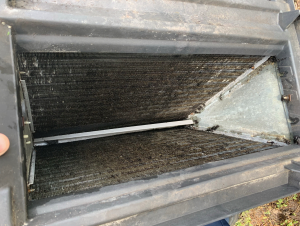
And after the cleaning – a full physical re-installation, of course.
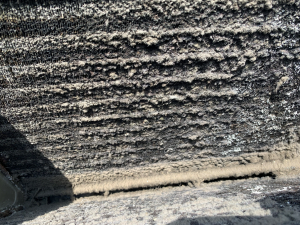
And this is why I won’t ever do this myself.
I was frankly a bit stunned this Evaporator Coil was so dirty as the entire HVAC system is only 3 years old. But more to come on that below.
Minimizing Air Handler Dirt and Germ Build-Up
Now, there are ways to minimize both dirt and biological contaminant build-up (mold and airborne bacteria, viruses & allergens) from within your Air Handler.
For dirt minimization, you simply must change your HVAC Air Filter every 3 months or so. This is super easy and not expensive. Remember – that Evaporator Coil during A/C operations is wet, so dirt (dust, smoke, etc.) can easily stick to it and build up significantly over time.
Keeping that dirt away via a clean, High-Quality HVAC Air Filter is the critical first line of defense.
Buy a case and make yourself a checklist as I do below, if it helps. The image that follows is from my basement workshop. I’m a huge fan of checklists. ;)
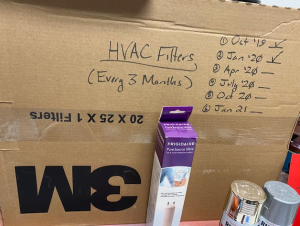
To address more of the biological items, you can install a UV light in your Air Handler.
The high energy HVAC UV (Ultraviolet) Light helps to inhibit mold growth and kill airborne germs.
The next shot is of an HVAC UV light from within my Air Handler – the same one from which the Evaporator Coil was pulled and cleaned. The bulbs are good for about 2 years, give or take. And yes, this was installed by a Local HVAC Professional as well.
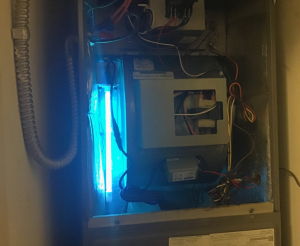
Evaporator Coil Removal & Cleaning Photos
The Evaporator Coil cleaning, in total, for this system took a little over ~2 hours.
This effort is 100% labor. The cleaning process itself isn’t complex once the coil is removed, but it has to be removed correctly and reinstalled correctly too.
Four more shots below – and in the last, you’ll see the beautifully clean Evaporator Coil.
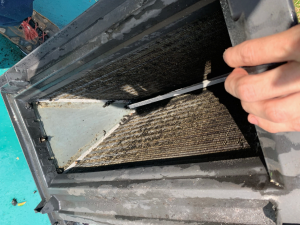
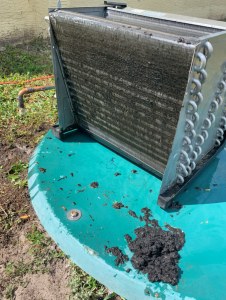
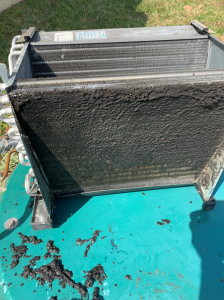

Now, the question on my mind is, “How the heck did this Evaporator Coil get so dirty in just 3 years?”
I could speculate, of course. Perhaps not-so-great HVAC Air Filters? Perhaps the filters weren’t changed as frequently as they could have been? Perhaps an abundance of dust and/or pollen in this house?? I can’t really be sure; I don’t live there, presently.
But this underscores the true criticality of routine professional HVAC inspections (visits every ~6 months) and routine replacement of High-Quality HVAC Air Filters (every ~3 months.) And perhaps even the consideration of a UV light in your Air Handler… maybe even more so if you’re in a particularly high-humidity part of the country or world.
At least that’s been my experience. Any other thoughts or insights anyone can share below?
Need Professional Help from a Local Contractor?
• Visit Our Find a Contractor Page
Related Posts
• How to Clean your Outdoor A/C Unit for Better Cooling
• My Wireless Waterproof Doorbell Epiphany
• Installing a Bathroom Ventilation Fan
• How to Replace a Dead GFCI Outlet
• Troubleshooting and Repairing a Broken Doorbell
• How to Repair a Leaky Basement Wall

Leave a Reply